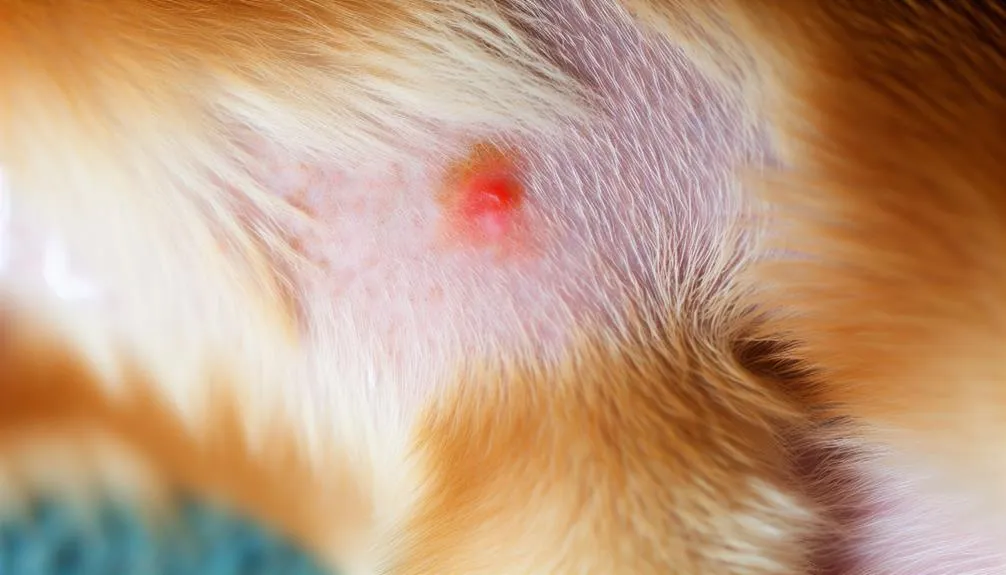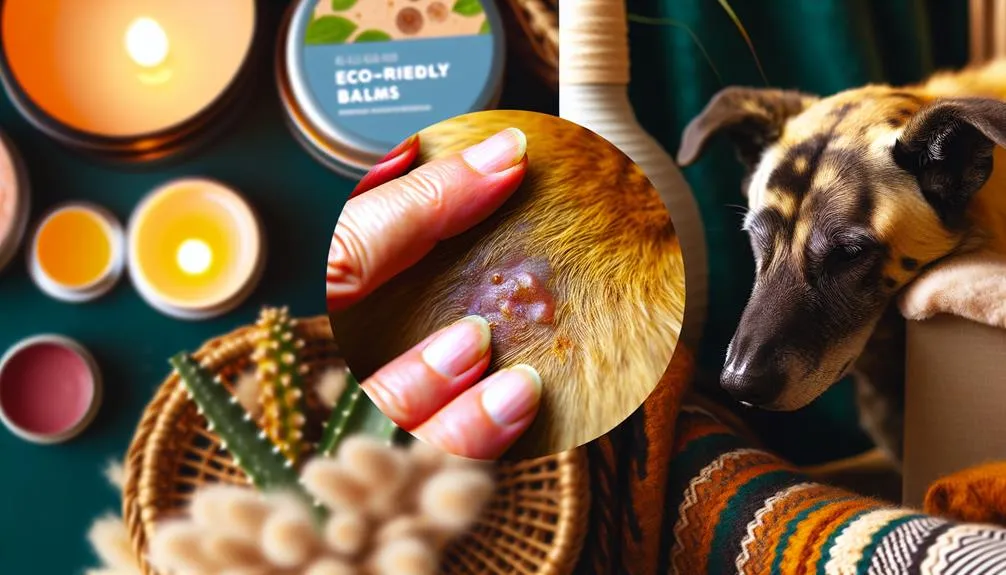
What Is a Hotspot on a Dog
Did you know that nearly 10% of dogs will experience a hotspot at some point in their lives? These painful, inflamed patches can develop quickly and often lead to significant discomfort for your pet. Understanding what causes these hotspots and how to identify them is essential for timely intervention. You might wonder what signs to look for or how to treat these conditions effectively, as well as ways to prevent them from reoccurring. Let's explore these aspects further to guarantee your dog stays comfortable and healthy.
Understanding Hotspots
Understanding hotspots on a dog requires a keen awareness of their underlying causes and symptoms. These localized areas of inflammation and infection can manifest as red, moist lesions, often accompanied by itching, pain, and discomfort. You may observe your dog incessantly licking or scratching the affected area, which can exacerbate the condition and lead to further skin damage. As a responsible pet owner, recognizing these symptoms early is vital for effective hotspot management.
Hotspots typically develop in areas where moisture accumulates, often exacerbated by factors like heat, humidity, and underlying skin conditions. They can occur anywhere on your dog's body but are most commonly found on the ears, paws, and hindquarters. The inflammation associated with hotspots can lead to significant discomfort for your dog, impeding their ability to rest and enjoy daily activities.
Effective hotspot management focuses on alleviating your dog's discomfort while addressing the underlying issues contributing to the condition. This includes maintaining proper hygiene, ensuring the affected area remains dry, and implementing topical treatments to relieve inflammation. You'll want to monitor your dog closely during this time, as they may require additional support to avoid further irritation.
Common Causes
Several factors can contribute to the development of hotspots on dogs, making it vital to identify these common causes for effective prevention and treatment. Hotspots, or acute moist dermatitis, can arise from various underlying issues that necessitate thorough allergies management and awareness of environmental factors. Understanding these causes can help you take proactive measures to safeguard your dog's skin health.
- Allergies: Dogs often suffer from food, flea, or environmental allergies, which can lead to intense itching and subsequent skin damage. Effective allergies management is significant in minimizing these triggers.
- Moisture: Excessive moisture, particularly in hot and humid conditions, can create an ideal environment for bacterial growth. Dogs that frequently swim or have wet fur can be particularly susceptible.
- Insect Bites: Fleas, ticks, and other insect bites can cause localized irritation, prompting your dog to scratch and lick the affected area relentlessly, increasing the likelihood of developing a hotspot.
- Skin Irritation: Factors such as poor grooming, irritants from shampoos, or contact with rough surfaces can lead to skin irritation. If your dog has matted fur or is not groomed regularly, it can exacerbate the situation.
Recognizing Symptoms

Recognizing symptoms of hotspots on your dog is essential for timely intervention and effective treatment. The initial signs often manifest as localized areas of itchy skin, which may lead to excessive scratching or licking. You might observe your dog obsessively grooming a specific spot, indicating discomfort. As the condition progresses, you'll likely notice the affected area becoming inflamed, red, and possibly exuding moisture or pus, which can signal a bacterial infection.
Pay close attention to the texture of the fur and skin around the hotspot. Hair loss is common in these areas, and the skin may appear scabbed or crusty due to self-trauma. In severe cases, you might observe a foul odor emanating from the affected area, which could further indicate a secondary bacterial infection. Your dog may also exhibit behavioral changes, such as increased restlessness or agitation, stemming from the persistent itchiness and discomfort.
Moreover, hotspots can develop rapidly, so monitoring your dog's skin regularly is essential. If you notice any of these symptoms, it's critical to act quickly to prevent worsening of the condition. Early identification can greatly affect the healing process and minimize your dog's distress. Remember, hotspots are not merely cosmetic concerns; they can lead to more serious complications if left untreated. As a result, being vigilant about these symptoms can make a considerable difference in your dog's health and well-being.
Diagnosis Process
When diagnosing a hotspot on your dog, a detailed visual inspection is essential to identify the extent and nature of the lesion. You'll need to understand the importance of a veterinary examination, as it provides an all-encompassing assessment that may involve diagnostic tests to rule out underlying issues. This systematic approach guarantees accurate diagnosis and effective treatment planning.
Visual Inspection Techniques
Visual inspection techniques are essential for accurately diagnosing hotspots on dogs, as they often provide the initial insight into the underlying issues. When you examine your dog, you'll want to focus on specific visual cues that can indicate hotspots or other skin conditions. Using appropriate inspection tools can enhance your assessment, making it easier to identify the problem areas.
Here are four key techniques to evaluate during your visual inspection:
- Examine the Skin Surface: Look for redness, swelling, or lesions that may indicate inflammation.
- Check for Hair Loss: Patchy areas of fur can suggest grooming habits or underlying allergies leading to hotspots.
- Assess the Area for Moisture: Hotspots often appear moist or oozing, providing critical information about infection.
- Observe Your Dog's Behavior: Pay attention to any excessive scratching or licking, as this can be a visual cue of discomfort.
Veterinary Examination Importance
Considering the complexity of skin conditions in dogs, a thorough veterinary examination is necessary for an accurate diagnosis of hotspots. During vet consultations, a detailed clinical assessment allows the veterinarian to differentiate between hotspots and other dermatological issues. It's essential for you to understand that hotspots can stem from various underlying causes, including allergies, parasites, or infections.
The examination typically involves a detailed skin assessment, where the vet will evaluate the affected area for signs of inflammation, hair loss, or secondary infections. They'll also gather your dog's medical history and may inquire about any recent changes in behavior or exposure to potential allergens. This information is critical for pinpointing the root cause of the hotspot.
In addition to visual inspection, palpation of the skin may reveal sensitivity or pain, guiding the veterinarian in their diagnostic process. Recognizing the importance of these vet consultations can lead to timely and effective treatment, preventing further complications. Remember, a proactive approach in seeking veterinary care not only aids in addressing hotspots but also promotes your dog's overall health and well-being.
Diagnostic Tests Overview
Conducting diagnostic tests is essential in accurately identifying the underlying causes of hotspots in dogs. These tests help you and your veterinarian determine the most effective treatment plan. Here's a breakdown of common diagnostic approaches:
- Physical Examination: Your vet will start with a thorough examination of the affected area, looking for signs of infection, inflammation, or other skin conditions.
- Biopsy Techniques: If the hotspot appears atypical, your veterinarian may recommend biopsy techniques to obtain tissue samples. This helps in ruling out skin tumors or other serious conditions.
- Allergy Testing: Identifying allergens is vital since hotspots can be triggered by environmental or food allergies. Your vet might suggest skin or blood tests to pinpoint specific allergens affecting your dog.
- Cytological Analysis: A sample of the fluid or tissue from the hotspot may be collected for cytological analysis. This test can reveal the presence of bacteria, yeast, or inflammatory cells, guiding treatment decisions.
Treatment Options

Treatment options for hotspots on dogs require a multifaceted approach to effectively manage the condition and promote healing. Initially, you should consider topical treatments such as antibiotic ointments, which are vital for preventing secondary bacterial infections. Applying these ointments can help reduce inflammation and facilitate faster recovery. Additionally, incorporating soothing shampoos into your dog's bathing routine can alleviate itching and cleanse the affected area, thereby enhancing comfort.
Hydrocortisone sprays are another practical option; they provide rapid relief from itching and inflammation. These can be used in conjunction with other treatments for maximum effectiveness. It is important to maintain moisture control in the affected area, as excessive moisture can exacerbate hotspots. Ensuring your dog's environment is dry and using moisture-wicking materials can greatly improve healing.
Dietary adjustments may also play a role, especially if allergies contribute to your dog's hotspots. A hypoallergenic diet or the introduction of natural remedies, such as omega fatty acids, can help improve skin health and overall resilience to skin conditions.
In severe cases, medical interventions may be necessary. Consulting with a veterinarian can lead to more thorough treatments, such as corticosteroids or oral antibiotics, particularly if the hotspot is extensive or persistent. Ultimately, the combination of these Treatment options tailored to your dog's specific needs will promote ideal healing and prevent future occurrences of hotspots.
Prevention Tips
To effectively prevent hotspots, you need to implement regular grooming practices that promote ideal skin health. This includes routine brushing to remove loose fur and debris, as well as checking for any signs of irritation or infection. Additionally, maintaining awareness of your dog's skin condition allows for early intervention, reducing the likelihood of hotspot development.
Regular Grooming Practices
Regular grooming practices are crucial for preventing hotspots on your dog, as they help maintain skin health and hygiene. Effective grooming not only removes dirt and debris but also promotes blood circulation, reducing the risk of skin irritations. Here are some key practices to incorporate into your routine:
- Choose Appropriate Grooming Tools: Select brushes and combs based on your dog's coat type. For example, slicker brushes work well for long-haired breeds, while bristle brushes are suitable for short-haired dogs.
- Implement Brushing Techniques: Use gentle, consistent strokes to remove loose fur and prevent matting. Focus on high-friction areas like the armpits and behind the ears, where hotspots commonly develop.
- Regular Bathing: Bathe your dog with a veterinary-recommended shampoo to eliminate allergens and irritants. Guarantee thorough rinsing to avoid residue that could lead to skin issues.
- Monitor Skin Condition: During grooming sessions, inspect your dog's skin for signs of redness, swelling, or irritation. Early detection of abnormalities can prevent the progression of hotspots.
Skin Health Awareness
Understanding your dog's skin health is essential for preventing hotspots and other dermatological issues. Skin irritation can arise from various factors, including allergies, environmental triggers, and poor grooming practices. By being proactive, you can greatly reduce the likelihood of hotspots developing.
One effective strategy is to identify and mitigate allergy triggers. Common allergens include certain foods, pollen, and dust mites. Regularly inspecting your dog's skin for any signs of irritation will help you catch issues early.
Here's a concise table summarizing key prevention tips:
| Prevention Strategy | Description | Frequency |
|---|---|---|
| Allergy Testing | Conduct tests to identify allergens | Annually |
| Skin Inspections | Check for redness, bumps, or lesions | Weekly |
| Moisturizing Treatments | Use vet-recommended moisturizers | As needed |
Frequently Asked Questions
Can Humans Catch Hotspots From Dogs?
You won't catch hotspots from dogs, as they're not contagious. However, recognizing hotspot symptoms is essential for prevention. Make certain your dog's skin stays clean and dry to minimize the risk of developing these painful lesions.
Are Certain Dog Breeds More Prone to Hotspots?
Certain breeds exhibit increased susceptibility to hotspots, often due to their coat types and grooming practices. Regular grooming can mitigate this risk, helping you maintain skin health and prevent irritation that leads to hotspots.
How Long Does It Take for Hotspots to Heal?
Healing's like watching a wound fade under sunlight; typically, hotspots heal within 1-3 weeks with proper hotspot treatments. Ensuring effective hotspot prevention strategies can greatly reduce recurrence and promote faster recovery for your furry friend.
Can Hotspots Cause Long-Term Skin Damage?
Yes, untreated hotspots can lead to long-term skin damage. To prevent this, guarantee proper hotspot prevention measures are in place, and initiate effective hotspot treatment immediately to mitigate potential complications and promote healing.
Is It Safe to Use Home Remedies on Hotspots?
It's essential you consult a vet before using home remedies for hotspots. While natural treatments may provide temporary relief, improper use can exacerbate skin issues, leading to potential complications and long-term damage that might require professional intervention.
Conclusion
In summary, addressing hotspots promptly is essential for your dog's comfort and health. Remember, "an ounce of prevention is worth a pound of cure." By understanding the underlying causes and recognizing symptoms early, you can effectively manage this condition. With appropriate Treatment options and preventive measures, you can help guarantee your dog remains happy and healthy, free from the discomfort of these painful lesions. Don't hesitate to consult a veterinarian for the best course of action.
You may also like
Archives
Calendar
| M | T | W | T | F | S | S |
|---|---|---|---|---|---|---|
| 1 | 2 | 3 | 4 | 5 | 6 | |
| 7 | 8 | 9 | 10 | 11 | 12 | 13 |
| 14 | 15 | 16 | 17 | 18 | 19 | 20 |
| 21 | 22 | 23 | 24 | 25 | 26 | 27 |
| 28 | 29 | 30 | ||||
Leave a Reply